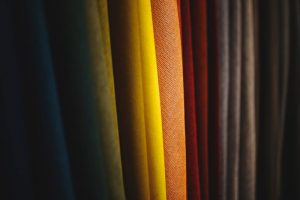
By Sirpa Välima
More than ever, people are looking for more sustainable ways to lead their lives. From the food they eat, to the transport they choose and even to the clothes they wear. Forward thinking retailers and designers such as IKEA1 and Marimekko2 have responded by experimenting with more sustainable, alternative materials, but overall our fast-fashion lifestyles and reliance on fossil materials keep us hooked on unsustainable textiles.
So where should we be looking for wardrobes that are green in every color? And what are the problems with our current array of common materials?
Fossil-Fueled Fashion
The world wears oil. As recently as 2016, 65 percent of global textile fiber volume was fossil-based fibers such as polyester and nylon3. They are cheap and easy to produce, with high performance on many measures: perfect for throwaway, fast fashion.
Except that we are becoming more conscious of what throwing away these materials means. These materials are plastics, and they do not biodegrade well in landfill, contributing to our pervasive plastic pollution problem.
However, the clothes don’t even need to be thrown away to cause problems. Every time we wash them, these clothes shed microplastics — as many as 700,000 fibers per 6 kg wash4. These microplastics make their way to our rivers and oceans and, from there, may make it into the food chain. What’s more, as products of fossil fuels, these materials have their share of the environmental blame for the broader oil and gas industry.
Keep It Organic?
What about natural alternatives then: wool, silk, linen, cotton?
Of these, only cotton is anything close to a serious contender, with 23 percent of the market. Wool accounts for 1 percent, and all other natural fibers only manage another 5 percent taken together5.
However, cotton is no environmental panacea. It takes as much as 12,000 liters of water to produce 1 kilogram (kg) of cotton. That’s almost three months worth of household water supplied directly to an individual European Union citizen — and cotton is often grown in areas suffering from drought. Pesticide and fertilizer use are also worryingly high6.
Retailers recognize this. H&M7 has set itself a goal of using 100 percent “preferred cotton” — meaning organic, recycled or “Better8” cotton.
 Natural Man-Made Materials
Natural Man-Made Materials
So, if synthetic materials are contributing to climate change and plastic pollution on the one hand, and natural contenders are too resource intensive, it seems we are stuck between a rock and a hard place.
But there is an alternative; materials that are both man-made in one sense and natural in another.
This may sound contradictory, but it is not. To explain: Viscose is a textile that is manufactured from pulp harvested from wood. So, it is man-made in that it is not directly grown like cotton, but natural in that it is made from a naturally occurring material.
Viscose can be a far more sustainable option for textiles. For a start, it is created from a renewable resource — trees — that can be regrown and even act as carbon sinks if responsibly managed. It also requires far less water than cotton — those 12,000 liters of water used to produce 1 kg of cotton would yield 26 kg of viscose.
Viscose also performs fantastically as a fabric. It is soft, smooth and breathable like cotton, but offers much better moisture management. It drapes well, has great luster and holds color and prints extremely well, even after many washes.
Not Your Grandmother’s Viscose
But viscose is not some new wonder material. It has been around for well over a century. At times, viscose has been a hugely popular fabric — as well as the basis for anything from cellophane to sponges to sausage casings — but has since suffered a decline.
This is largely down to concerns over the use of carbon disulphide in the manufacturing process. A dangerous and toxic chemical, carbon disulphide has resulted in worker safety incidents in developing countries, and its environmental impact has dented viscose’s eco-credentials. At the same time, beginning in the 1970’s, tighter emissions standards for European businesses raised costs and led to outsourcing production to China.
However, modern viscose is changing. Current production processes for both viscose and other man-made cellulosic fibers focus on a high recovery rate of chemicals and closed chemical loops, greatly reducing environmental harm. Widespread investment into worker health and safety and environmental controls also means that even viscose made using traditional processes is becoming safer and more environmentally friendly.
A future is in sight where viscose is the sustainable answer to sate the global textile industry’s demand for beautiful and high-performance materials. Our industries and societies are increasingly mindful of the impact they have on the planet and are realizing that the future must be built using renewable materials. As in so many things, we can look to the forest to inspire a renewable future.
References:
2 https://twitter.com/Marimekkoglobal/status/444190374622662657
3 Source: CIRFS, The Fiber Year
4 https://www.sciencedirect.com/science/article/pii/S0025326X16307639
5 Source: CIRFS, The Fiber Year
6 https://www.worldwildlife.org/industries/cotton
7 https://about.hm.com/news/general-news-2019/on-the-way-towards-using-100–sustainable-materials.html
Editor’s Note: Sirpa Välima is product manager, dissolving pulp at Helsinki-based Stora Enso, a global provider of renewable solutions in packaging, biomaterials, wooden constructions and paper.
August 16, 2019




